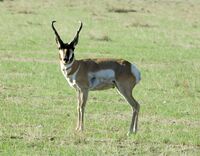Pronghorn
| Pronghorn antelope | |
|---|---|

| |
| Scientific classification | |
| Kingdom Information | |
| Domain | Eukaryota |
| Kingdom | Animalia |
| Subkingdom | Bilateria |
| Branch | Deuterostomia |
| Phylum Information | |
| Phylum | Chordata |
| Sub-phylum | Vertebrata |
| Infraphylum | Gnathostomata |
| Class Information | |
| Superclass | Tetrapoda |
| Class | Mammalia |
| Sub-class | Theriiformes |
| Infra-class | Holotheria |
| Order Information | |
| Superorder | Preptotheria |
| Order | Artiodactyla |
| Sub-order | Ruminantia |
| Infraorder | Pecora |
| Family Information | |
| Superfamily | Giraffoidea |
| Family | Antilocapridae |
| Sub-family | Antilocaprinae |
| Genus Information | |
| Genus | Antilocapra |
| Species Information | |
| Species | A. americana |
| Subspecies | A. a. americana A. a. mexicana A. a. oregona A. a. peninsularis A. a. sonoriensis |
| Population statistics | |
| Population | 1,000,000 (2011 est.) |
| Conservation status | Least concern[1] |
Pronghorns, which belong to the family Antilocapridae, is the fastest animal in North America reaching speeds of up to 58 mph. The Pronghorns closest relative is the antelope, and is sometimes even referred to as the Pronghorn Antelope, even though it is a unique species. The horns on Pronghorns are universal for both males and females, although much smaller in females. The horns are made up of a hair like material that is supported by a bone core. The Pronghorn species was specifically discovered by the Lewis and Clark Expedition. Antilocapra americana is the most common pronghorn, but there are three other species that are now endangered which are A . sonoriensis, A. peninsularis, A. mexicana.[1]
Anatomy
The weight of a newly born pronghorn is extremely insignificant to that of an adult. At birth, the approximate weight ranges from 5 - 9 pounds. An adult male, when fully grown, weighs approximately 100 - 145 pounds, while adult females weigh about 75- 100 pounds. The coloration of Pronghorns are universal for almost all the known species. As adults, the the body is a tan or brown color, while the backside of the animal is white. There are two white stripes on the throat. A small brown mane grows on the throat, and males have a black "mask" on the face. Although all pronghorns, both male and female, have horns, there is a large difference in the size. Male horns range from 5 to 17 inches in length and are curved. The horns on females are 1-6 inches long and are sometimes not even visible to the naked eye.[2] The eye sight of Pronghorns is a remarkable tool. The sight of Pronghorns is up to 8x the binocular vision capability of a human being. They are also able to see a 270 degree radius around them. [3]
Subspecies
- Antilocapra americana americana; Canada: southern Saskatchewan and Alberta to United States: southwestern Minnesota, south to central Texas, west to southern California coastline
- Antilocapra americana mexicana; northern Mexico, southern United States
- Antilocapra americana oregona; United States (Oregon)
- Antilocapra americana peninsularis; Mexico (Baja California Sur)
- Antilocapra americana sonoriensis; Arizona to northern Mexico (Sonora)
Reproduction
Female Pronghorns have a longer gestation period that most other hoofed animals in North America. Pronghorns move in herds and usually mate in late September. The female carries the fawn until May. This is another way that pronghorns are unique from other so-called relatives, because this long carriage is about 6 weeks longer than any other "hoofed-animal". [4] After the fawn is born, the mother protects it until it is able to walk and is able to nip and feed itself. At about six months is when the horns become evident. When the young is about one year of age, it has reached sexual maturity in both sexes.[5]
Hunting
In the early 1900's the Pronghorn population was rapidly reduced to about 20,000, due to the large amount of hunting that was going on. But then there were large protection laws on the habitats of the animals which increased the amount of Pronghorns to about 500,000. The main predators of the Pronghorns are the wolves, coyotes and bobcats. A very interesting fact is that eagles and hawks have been known to prey on the fawns.[6]
Ecology
Pronghorns live mostly in the plains. They range from Alberta, Canada to Mexico. They also live on both sides of the Rocky mountains. Their habitat extends as far east as the Missouri River. Their diet mostly depends on what terrain they inhabit. They are able to live in grasslands as well as desert. In general, they eat cacti, grasses, forbs, and browse plants.[7] Their feet also adapt to the surroundings, making it easy for them to run swiftly, reaching speeds of about 59 mph. as referred to in the introduction. Their bodies have the special ability to conserve water, so that they do not necessarily have to drink large amounts of water. [8]
Gallery
Related References
- Pronghorn wikipedia
- The Mammals of Texas - Online Edition (Pronghorns)
- Pronghorns Great Plains Nature Center6232 E. 29th Street North Wichita, KS 67220-2200 All pictures by Bob Gress




